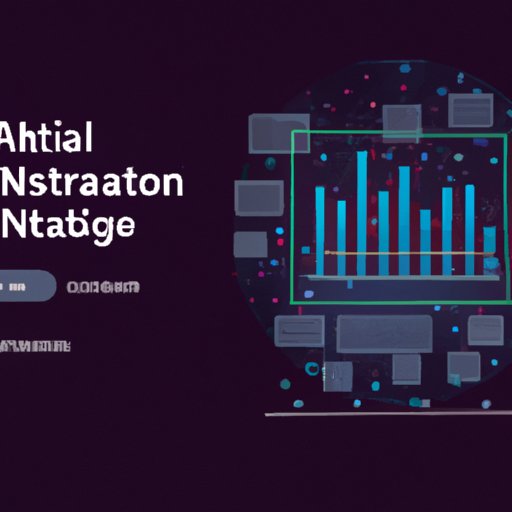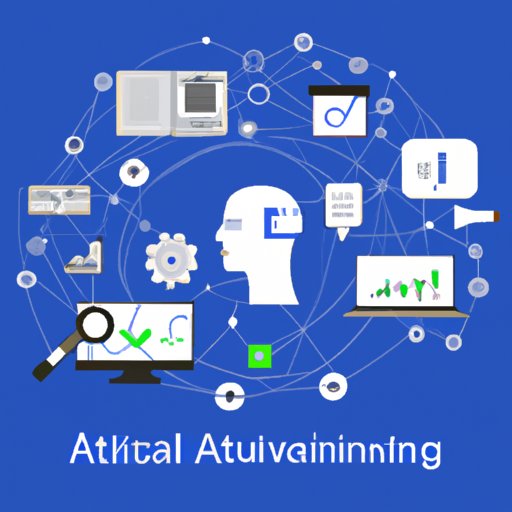Introduction
Data analysis is an essential part of any business, as it helps identify trends, patterns, and opportunities. Artificial intelligence (AI) has revolutionized the way businesses analyze data, enabling them to make more informed decisions and improve efficiency. AI-driven data analysis refers to the use of AI technologies to analyze data and extract insights from it. This article will explore how AI can be used to analyze data, including understanding AI algorithms, investigating AI tools, examining the role of AI in data analysis, exploring AI applications, and evaluating the impact of AI on data analysis strategies.
Understanding AI Algorithms for Data Analysis
AI algorithms are a set of instructions or rules used to solve a problem. They are used to automate tasks such as decision making, pattern recognition, and classification. There are various types of AI algorithms, including supervised learning algorithms, unsupervised learning algorithms, and reinforcement learning algorithms. Supervised learning algorithms are used to classify data into different categories. Unsupervised learning algorithms are used to identify patterns and clusters in data. Reinforcement learning algorithms are used to optimize decisions based on previous experiences.
When it comes to data analysis, AI algorithms can be used to identify patterns and correlations in data and draw insights from it. For example, AI algorithms can be used to identify customer buying patterns, detect fraud, and predict customer churn. AI algorithms can also be used to identify anomalies in data, such as outliers that may indicate potential problems.
“AI algorithms are now being used to analyze large amounts of data in order to uncover patterns and correlations that were previously difficult or impossible to detect,” says Dr. Lillian Pierson, author of Data Science for Dummies. “These algorithms can help organizations gain valuable insights about their customers, products, and operations.”
Investigating AI Tools Used for Data Analysis
AI tools are computer programs that use AI algorithms to analyze data. These tools enable businesses to quickly and accurately analyze large amounts of data. Common AI tools include machine learning platforms, natural language processing (NLP) systems, image recognition software, and speech recognition technology.
One of the main advantages of using AI tools for data analysis is that they can process large amounts of data quickly and accurately. They can also identify patterns and correlations that are difficult for humans to detect. Additionally, AI tools can automate processes such as data collection and analysis, saving businesses time and money.
However, there are some challenges associated with using AI tools for data analysis. AI tools require large amounts of data to be accurate and reliable. Additionally, they need to be regularly updated to keep up with changing data patterns. Finally, AI tools can be expensive, and implementing them requires specialized knowledge and skills.

Examining the Role of AI in Data Analysis
AI can play an important role in data analysis by enhancing predictive analytics, increasing accuracy and efficiency, and automating processes and data collection. Predictive analytics is the process of using data to predict future events. AI algorithms can be used to identify patterns in data and make predictions about future outcomes.
AI can also increase accuracy and efficiency by automating manual processes. AI algorithms can be used to identify patterns in data that are difficult for humans to detect. Additionally, AI tools can automate data collection and analysis, reducing the time and cost required to gather and analyze data.

Exploring AI Applications to Extract Insights from Data
AI applications are used to extract insights from data. Machine learning is a type of AI application that can be used to identify patterns and correlations in data. Natural language processing (NLP) systems can be used to analyze text and identify topics and sentiment. Image recognition technology can be used to identify objects in images and videos. Speech recognition technology can be used to transcribe audio recordings into text.
These AI applications can be used to extract insights from data. For example, machine learning algorithms can be used to identify customer segments and predict customer churn. NLP systems can be used to analyze customer feedback and identify customer sentiment. Image recognition technology can be used to identify objects in images and videos. Speech recognition technology can be used to transcribe audio recordings into text.

Evaluating the Impact of AI on Data Analysis Strategies
AI can have a significant impact on data analysis strategies. AI algorithms and tools can save businesses time and money by automating manual processes and data collection. Additionally, AI algorithms can identify patterns and correlations in data that are difficult for humans to detect, resulting in more accurate and efficient decision making.
AI can also reduce costs by improving the efficiency of data analysis. AI algorithms can process large amounts of data quickly and accurately, enabling businesses to make better decisions faster. Additionally, AI algorithms can identify anomalies in data that may indicate potential problems.
Conclusion
AI-driven data analysis is revolutionizing the way businesses analyze data. AI algorithms and tools can be used to automate processes, identify patterns and correlations in data, and extract insights from it. By leveraging AI-driven data analysis, businesses can save time and money, improve accuracy and efficiency, and make better decisions faster.
From understanding AI algorithms to exploring AI applications, this article has explored how AI can be used to analyze data. AI algorithms and tools can automate processes and data collection, improve predictive analytics, and increase accuracy and efficiency. Businesses should consider leveraging AI-driven data analysis to improve their data analysis strategies and gain a competitive edge.
(Note: Is this article not meeting your expectations? Do you have knowledge or insights to share? Unlock new opportunities and expand your reach by joining our authors team. Click Registration to join us and share your expertise with our readers.)
